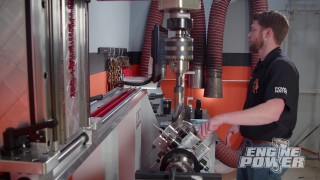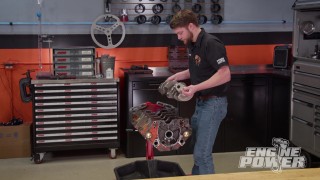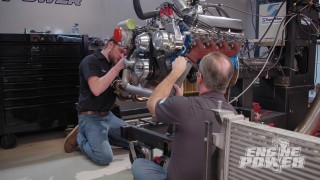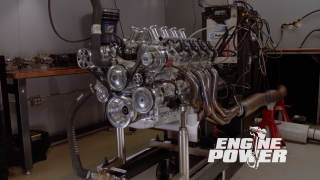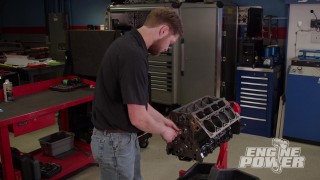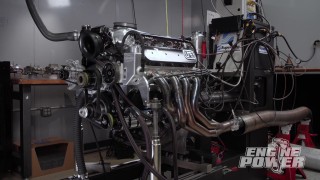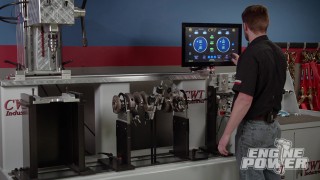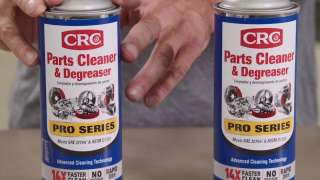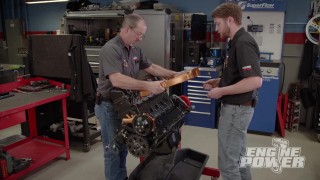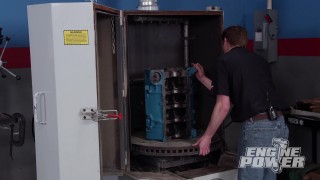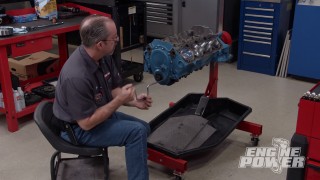Engine Power Featured Projects
Engine Power Builds
Want more content like this?
Join the PowerNation Email NewsletterParts Used In This Episode
Matco Tools
MATCO Tools are the Official Tool Supplier to PowerNation
The Industrial Depot
Tools, Hardware, Shop Supplies
Episode Transcript
(Mike)>> You're watching Powernation!
(Pat)>> This old piece of Ford iron fired right up when we gave it fuel and spark. Today we give it power.
(Mike)>> Whoa!
(Pat)>> That is a new engine right there. [ MUSIC ]
(Mike)>> It's fair to say we all have our preference for things we like. There's Chevy fans, Mopar lovers, Ford followers, and even if you like imports that's okay too. We just all have to work together to keep the automotive industry strong, and with the car culture we all share we can do that for years to come. It's something that we all have to work on together, and that is something we all have in common. So with that being said today this next project may not be up your alley but it's cool and deserves some attention.
(Pat)>> Today is not about a V-8 or even making big power. We are getting back on a project that has had a ton of accomplishments and has been known to be one of the best engines ever designed. It has won the Baja 1,000 three times, has delivered packages to you in UPS trucks, and it has an industrial side being found on farms and job sites. You may even have had one back in 1965 in an F-series pickup all the way up to 1996. This is the 4.9 liter 300 cubic inch inline six cylinder from Ford.
(Mike)>> This one is ours. It's definitely an industrial version, which had better parts than the standard truck engines, like a forged crankshaft. We found this contraption in Colorado, and had it shipped here. It was on the back of a truck at some point and was used as a sprayer. Now we wanted to get it running where it sits but the ring gear for the flywheel was removed at some point. So we pulled it and put it straight on the dyno cart. Now it was hooked up to the dyno, a new carburetor dropped on, and a few things were checked out. With fuel and water flowing it was started for the first time in a long time.
(Pat)>> Woo hoo hoo! It's working! Oh my god!
(Mike)>> It ran awesome with no leaks, knocks, or pings. So some power pulls were in order. It went right through the sweep and here's what it made. [ engine revving ]
(Pat)>> As far as we can tell this engine has never been messed with, but we are going to change that today. We have some performance parts that we will be installing on a step by step basis to see how they affect power. Now they are gonna be a mixture of performance parts that are off the shelf from different manufacturers, and you can buy them all at Summit Racing Equipment.
(Mike)>> The first part that we are going to bolt on is a Hooker header. It's a six into two long tube design that has a one and five-eighths inch primary tube diameter and two and a half inch collectors. The second performance goodie is an Offenhauser C-series manifold. It will increase power and torque through the r-p-m range. It has a square bore flange. So it accepts a four barrel carburetor.
(Pat)>> Roller rockers are always a great upgrade to the valvetrain. These are Harlan Sharp's stud mount rockers that sport a 1.6 ratio. They are a full roller and have an aluminum body. This is a Summit Racing h-e-i, or high energy ignition, distributor. It's blue printed, has a magnetic pickup, plus mechanical and vacuum advance. The coil that's included produces 50,000 volts. Does this catch your attention? Let's just say this engine will be around for a little while and we have some super cool plans for it. We don't need this mechanical governor, and lucky for us it was barely hooked up to begin with. To increase our chances of removing these very old and rusty fasteners we'll spray them with Seafoam Deep Creep. Some of the fasteners came out easily while others needed persuasion. [ MUSIC ] [ ratchet clicking ] [ MUSIC ]
(Pat)>> This is either gonna go really good or really bad right here. [ MUSIC ] Yeah baby! [ ratchet clicking ]
(Pat)>> We didn't find any surprises behind the manifold. We knew there'd be years' worth of oil deposits. The engine actually ran better than you'd think based on the way it looks. [ metal banging ]
(Pat)>> Look at that. We wanted to reuse the stock exhaust manifold just for testing purposes. We just broke the manifold. But sometimes you have to change your plans. With a clear shot at the cylinder head the intake and header bolted up relatively easy with some minor tweaks.
(Mike)>> Oh man!
(Pat)>> Oh my!
(Mike)>> Dude I'm flush. [ drill humming ] [ MUSIC ]
(Pat)>> To say the carb is small would be an understatement. We ruined the original gasket but a modified thermostat gasket worked just fine. With the headers installed we're going back to the torture chamber. Every painted header will smoke on initial fire up. To make sure we get accurate numbers on the dyno we'll let the excess paint burn off before making a run. Come on sewing machine. [ engine idling ] [ engine revving ]
(Pat)>> Oh yeah!
(Mike)>> Nice little pull.
(Pat)>> 93.7, I'm gonna call 94, 226 pound feet of torque.
(Mike)>> Not bad!
(Pat)>> That's better than what the stock exhaust manifold was right? Now that affects the carburetor. That affects a bunch of stuff. We just literally jammed the header on and made a pull. We've mismatched some parts immediately when we put that big header on there.
(Mike)>> We're up 5 from the stock one.
(Pat)>> That's worth it. That is 5 percent power. Up next we like things that make life in the shop easier. We love being able to build them ourselves.
(Pat)>> Here's a better way to install brake pads in today's tech tip.
(Tim)>> Using a C-clamp to compress caliper pistons when replacing brake pads works fine, but if you're not dead on center a C-clamp can cock the piston in the bore and damage either or both and it takes a fair amount of effort to compress the caliper pistons, and twisting the little handle on a C-clamp can put the hurt on your hands and wrists. A brake pad spreader like this one from Lyle makes the job quick and easy. Fit the tool inside the caliper and squeeze the handle. The pads compress the piston smoothly and evenly on calipers with up to four pistons.
(Mike)>> Having the right tools and equipment always makes the job easier. Now as we work on things we add to our tool arsenal to get the job done. This also means you're going to be prepared better the next time around. Now this covers a wide variety of things from hand tools to power and air ones, and even more complex items like scanners and even welders, which is the topic we're going to handle.
(Pat)>> Welders and welding equipment are offered by several different companies, from entry level all the way up to professional welding equipment. They're handy to have around any shop or even if you are a hobbyist or an artist since you can weld metal art together with it. They are especially important in the automotive industry from working on a factory assembly line all the way to your back yard, like welding a cage in your hot rod.
(Mike)>> We use welders on a regular basis here in the shop. Typically it's mig and tig, but sometimes we do break out a stick welder. Today we're gonna cover a new mig welder that we got in a little while ago. Now I've used it several times and it's a fine machine. It also has a color that you won't forget once you see it. Everybody say hello to the Forney Industries 220 multi-process mig welder. This welder has a ton of features in a great size. It's multi-process, so it can be used for mig, tig, stick, and flux cord. It works with 120 or 240 volt and has an amp range from 80 amps using 120 volt to 200 amps on 240. The welding capacity of this machine is half inch. It can be spooled up with 30 or 35 thousandths wire diameters and can be used on solid steel, stainless, cast iron, and aluminum when using a spool gun. The digital displays are super bright and easy to read. Now the setup also sports an all metal drive system. Here's a quick look at all the accessories that come with the welder. You get a 200 amp Pro Grip mig gun, ground clamp with cable, electrode holder with cable, and input power cable, flow gauge with hose, and extra contact tips. This is the ideal welder that will handle do it yourself projects or turn up the wick and it can be used as a light industrial welder. With all of the one inch square tube for the cradle cut to length we can start welding it together. A square is used to, guess what, keep it square. It tacks the tubes together nice and clean. There's hardly any slag at all. When laying the welds down the machine is very stable. The mig torch is very comfortable, and Forney's automatic welding helmet protects the eyes great. If you have been intimidate by welders because of the settings and not knowing how to adjust the machine that is over. Forney includes a setup chart on the inside of the spool door that tells you everything you need to know.
(Pat)>> In every shop there is always something that needs welding. Given the 220 MP's ease of use and affordable price there's no reason not to have one in your shop.
(Mike)>> It's important to re-check your measurements occasionally as your welding just in case any of the pieces have gotten knocked out of alignment or distorted by the heat of the welding process. Everything looks good, so we'll keep going.
(Pat)>> After the engine cradle cools down it's bolted up to the back of the engine. A tab made from eighth inch flat stock is fastened to the side of the engine and some one inch square tube is used to brace it. [ welder crackling ]
(Mike)>> To protect the cradle from rust and corrosion we'll give it a couple of coats of black engine enamel. The end result looks really professional and works great. Not bad for a couple of hours work and about $25 dollars worth of tubing.
(Pat)>> Building the cradle was a good deed today because we have to ship this engine out, and we can thank green for that. Now if you want to learn more about the welders go to Forney IND dot com. Up next, engines are like athletes. For them to really perform they've got to breathe.
(Pat)>> We are still in the dyno room putting some parts on our 300 Ford project before we tear it down to do the big build, and the first thing we've done is we've replaced the stock exhaust manifold with a header. Now we did show a little bit of a gain. We cracked 90 horse. We made 93.7 horsepower, 226 pound feet of torque. That is up from the old peak numbers, but it doesn't tell the whole story. What tells the story are the average numbers. From 1,500 to 3,500 now with the header on it is up 18.5 pound feet of torque and it is up 8.7 horsepower. Doesn't sound like a lot but considering that the engine only makes 90 horsepower that is a 20 percent gain in power over our average, and that's what makes things run good. Now before we do anything else I think we're gonna try and help it on the ignition side. Our points distributor works nice but we are gonna upgrade it with an h-e-i style from Summit Racing. This is a blue printed distributor and has an h-e-i style cap just like a Chevy with a coil on top. We're gonna make up some new wires and we're gonna see if that helps us on power. The new wires and distributor will certainly improve performance and reliability. Plus installing a modern distributor means we can finally ditch that ballast resistor we had to use with the points setup. Alright we have a fresh distributor and wires in it. Now the only thing we have done is changed that. So we have set the timing back to where it was with the points distributor and we're literally gonna see how it runs. It started up, so let's see what happens here.
(Mike)>> Here we go! [ engine revving ]
(Pat)>> So far so good. [ engine revving ]
(Pat)>> Hey look at that! That's an improvement!
(Mike)>> 94 horse, 232 pound feet.
(Pat)>> Right now we are adding improvement, very slightly, but a little bit better quality spark maybe. Spark is almost spark at something at this power level, but that's an improvement.
(Mike)>> That's nice!
(Pat)>> All in one having the coil on it makes a little bit better for packaging. You don't have to have that ballast resistor in there. I think it's a little bit better setup, and it looks good, runs good.
(Mike)>> Well the wires are a testament too, the MSD wires. You have a lower ohms resistance per foot. So you were leaning somewhere before we did that. So let's go ahead and see what happens when we open up the intake side.
(Pat)>> I think we could definitely make an improvement on the intake side of this engine.
(Mike)>> And we have something for it.
(Pat)>> We have a little something something for it. Industrial engines are often built to run long but not strong, and the induction setup on the 300 handles the job well. Since we're looking for more power we're installing an Offenhauser C-series intake manifold. It lets us run a four barrel carburetor delivering enough fuel and air to the cylinders to hopefully make a sizeable power gain. The carb is a well-used Street Demon from a previous project and it's rated at 625 c-f-m. Yeah that's the carb that was off the Sea Foam Camaro original engine. So we know it runs, and it ran okay. This will be a good one. I think the engine will turn higher. So crank it up to 4,000. I bet you this is gonna be significant because the manifold vacuum on the old one, on that little log manifold, had over nine inches of vacuum.
(Mike)>> And a one barrel in that little hole. Alright who's ready? [ engine revving ]
(Pat)>> Not bad!
(Mike)>> Hold it right down, wow! [ engine revving ]
(Pat)>> That is a new engine right there. [ MUSIC ]
(Mike)>> Whoa, 166.5 on power and 277.7 pound feet.
(Pat)>> That is a new engine.
(Mike)>> Alright let's back it up. We've got to back it up just real quick.
(Pat)>> Just to say we did.
(Mike)>> That's a percentage gain right there. Alright here we go! [ engine revving ]
(Pat)>> It doesn't actually mind that carburetor too much. [ engine revving ]
(Mike)>> That's it man.
(Pat)>> That's sweet right there! 166.27, it's gonna print numbers now.
(Mike)>> And you're exactly right, look at what it did with manifold vacuum.
(Pat)>> It's gonna be under one inch. It was over nine inches and now. So there's a good example of manifold restriction right? You have a one barrel and a very restrictive intake tract and we literally did nothing. We didn't change the cam, we didn't change a spring. We did this in incremental changes and now we've taken an engine that topped out at 95 horse and now it's making 166 by a manifold and carb.
(Mike)>> Insane! Cleaning dirty parts is never fun. They can be oily, greasy, or covered in dirt and fuel and you want to get them clean as fast as you can so you can move on. Well CRC has the answer with their new parts cleaner and degreaser pro series. This stuff cleans parts up to 14 times faster than the competitors. It won't leave any residue, dries super-fast, and the can is equipped with the power jet nozzle to provide a strong spray. It works great on metal automotive parts like carburetors, chokes, air intakes, brake drums, rotors, calipers and more. You can find it at your local parts start.
(Pat)>> When it comes time to repair or upgrade your ride there are two costs involved, labor and parts, and even if you're taking care of the labor yourself you still want a great price on high quality parts. Rock Auto dot com has a deep inventory. So matter what you drive they can help. They offer a full range of parts from economy and o-e-m replacement all the way up to premium aftermarket. The website is organized by make, year, model, and category. So you can find what you're looking for quickly. You can also search by part number too. In addition to model specific parts you'll find plenty of general purpose tools, automotive fluids, and more. Shipping is fast and accurate. Go check out Rock Auto dot com to get going on your project vehicle. Up next picking up power and durability with our inline six.
(Pat)>> The Ford 300 inline six almost doubled its horsepower after changing the induction setup but we're not done yet.
(Mike)>> Well we're on a good path so far. Everything's picked up power.
(Pat)>> This is like a time capsule right here. [ MUSIC ] Look at this gem.
(Mike)>> Wow!
(Pat)>> That is extremely clean.
(Mike)>> There's nothing sitting in the head.
(Pat)>> Wow! [ MUSIC ] We're replacing the stock sled fulcrum rockers with a set of Harlan Sharp aluminum roller rockers. They have roller trunnions and tips for less friction and increased durability. The rockers are a true 1.6 ratio and will work with the stock length push rods. We'll adjust them to a quarter turn past zero lash on this stock flat tappet hydraulic lifter setup. Comp Cams valvetrain assembly spray will pre-lube everything before initial fire up. The poly lock set screws are torqued to 18 pound feet. [ MUSIC ] Alright rocker arm change, aside from all the other things that we've done, this is one of the big things we've actually had to crack the valve cover off and put an internal part in it. So I hope it does something. If nothing else it's good for longevity, and we're gonna use them anyway in another build. It'll be interesting to see what this does versus a stock set of sled fulcrum rockers.
(Mike)>> I've got all the notes in, same pull, ready to rock.
(Pat)>> Give her the business. [ engine revving ]
(Pat)>> Still nice and clean. [ engine revving ]
(Pat)>> Might have snuck a couple more in her.
(Mike)>> I think it did. I saw the torque number, it was pretty good.
(Pat)>> Look at that, 280.8 and 169 horse. We're so close to 170 horse.
(Mike)>> Well watch this. It's either gonna do it or it won't.
(Pat)>> Get a little heat in her. What's nice about this one with that thermostat in it it's maintaining water temp, and we can go for the glory number and cool it way down, but this is way more realistic and real world. [ engine revving ]
(Mike)>> I don't think it got there. [ MUSIC ] That torque number laying it down.
(Pat)>> 280 and I mean that's a half a horse. That's within the repeatability of the dyno. Dude that's nice! Take a look how the engine upgrades performed. From a baseline of 88 horsepower and 217 pound feet of torque the header gained an additional 5.7 peak horsepower and 9 peak pound feet of torque. Changing the distributor and spark plug wires added another 1.2 peak horsepower and another 6.2 pound feet. The manifold and carb upgrade made the biggest difference adding 71.1 peak horsepower and another 45.8 pound feet. Finally the rocker swap yielded 3.5 peak horsepower and 2 more pound feet of torque. That's a total gain of 81.5 peak horsepower and 63 peak pound feet of torque versus the baseline run. The average numbers in the operating range of 1,500 to 3,500 r-p-m are even better. They are up 51.4 horsepower and 101.5 pound feet of torque. This feels and sounds like a completely different engine. For more information on anything you've seen today visit Powernation TV dot com.
Show Full Transcript
(Pat)>> This old piece of Ford iron fired right up when we gave it fuel and spark. Today we give it power.
(Mike)>> Whoa!
(Pat)>> That is a new engine right there. [ MUSIC ]
(Mike)>> It's fair to say we all have our preference for things we like. There's Chevy fans, Mopar lovers, Ford followers, and even if you like imports that's okay too. We just all have to work together to keep the automotive industry strong, and with the car culture we all share we can do that for years to come. It's something that we all have to work on together, and that is something we all have in common. So with that being said today this next project may not be up your alley but it's cool and deserves some attention.
(Pat)>> Today is not about a V-8 or even making big power. We are getting back on a project that has had a ton of accomplishments and has been known to be one of the best engines ever designed. It has won the Baja 1,000 three times, has delivered packages to you in UPS trucks, and it has an industrial side being found on farms and job sites. You may even have had one back in 1965 in an F-series pickup all the way up to 1996. This is the 4.9 liter 300 cubic inch inline six cylinder from Ford.
(Mike)>> This one is ours. It's definitely an industrial version, which had better parts than the standard truck engines, like a forged crankshaft. We found this contraption in Colorado, and had it shipped here. It was on the back of a truck at some point and was used as a sprayer. Now we wanted to get it running where it sits but the ring gear for the flywheel was removed at some point. So we pulled it and put it straight on the dyno cart. Now it was hooked up to the dyno, a new carburetor dropped on, and a few things were checked out. With fuel and water flowing it was started for the first time in a long time.
(Pat)>> Woo hoo hoo! It's working! Oh my god!
(Mike)>> It ran awesome with no leaks, knocks, or pings. So some power pulls were in order. It went right through the sweep and here's what it made. [ engine revving ]
(Pat)>> As far as we can tell this engine has never been messed with, but we are going to change that today. We have some performance parts that we will be installing on a step by step basis to see how they affect power. Now they are gonna be a mixture of performance parts that are off the shelf from different manufacturers, and you can buy them all at Summit Racing Equipment.
(Mike)>> The first part that we are going to bolt on is a Hooker header. It's a six into two long tube design that has a one and five-eighths inch primary tube diameter and two and a half inch collectors. The second performance goodie is an Offenhauser C-series manifold. It will increase power and torque through the r-p-m range. It has a square bore flange. So it accepts a four barrel carburetor.
(Pat)>> Roller rockers are always a great upgrade to the valvetrain. These are Harlan Sharp's stud mount rockers that sport a 1.6 ratio. They are a full roller and have an aluminum body. This is a Summit Racing h-e-i, or high energy ignition, distributor. It's blue printed, has a magnetic pickup, plus mechanical and vacuum advance. The coil that's included produces 50,000 volts. Does this catch your attention? Let's just say this engine will be around for a little while and we have some super cool plans for it. We don't need this mechanical governor, and lucky for us it was barely hooked up to begin with. To increase our chances of removing these very old and rusty fasteners we'll spray them with Seafoam Deep Creep. Some of the fasteners came out easily while others needed persuasion. [ MUSIC ] [ ratchet clicking ] [ MUSIC ]
(Pat)>> This is either gonna go really good or really bad right here. [ MUSIC ] Yeah baby! [ ratchet clicking ]
(Pat)>> We didn't find any surprises behind the manifold. We knew there'd be years' worth of oil deposits. The engine actually ran better than you'd think based on the way it looks. [ metal banging ]
(Pat)>> Look at that. We wanted to reuse the stock exhaust manifold just for testing purposes. We just broke the manifold. But sometimes you have to change your plans. With a clear shot at the cylinder head the intake and header bolted up relatively easy with some minor tweaks.
(Mike)>> Oh man!
(Pat)>> Oh my!
(Mike)>> Dude I'm flush. [ drill humming ] [ MUSIC ]
(Pat)>> To say the carb is small would be an understatement. We ruined the original gasket but a modified thermostat gasket worked just fine. With the headers installed we're going back to the torture chamber. Every painted header will smoke on initial fire up. To make sure we get accurate numbers on the dyno we'll let the excess paint burn off before making a run. Come on sewing machine. [ engine idling ] [ engine revving ]
(Pat)>> Oh yeah!
(Mike)>> Nice little pull.
(Pat)>> 93.7, I'm gonna call 94, 226 pound feet of torque.
(Mike)>> Not bad!
(Pat)>> That's better than what the stock exhaust manifold was right? Now that affects the carburetor. That affects a bunch of stuff. We just literally jammed the header on and made a pull. We've mismatched some parts immediately when we put that big header on there.
(Mike)>> We're up 5 from the stock one.
(Pat)>> That's worth it. That is 5 percent power. Up next we like things that make life in the shop easier. We love being able to build them ourselves.
(Pat)>> Here's a better way to install brake pads in today's tech tip.
(Tim)>> Using a C-clamp to compress caliper pistons when replacing brake pads works fine, but if you're not dead on center a C-clamp can cock the piston in the bore and damage either or both and it takes a fair amount of effort to compress the caliper pistons, and twisting the little handle on a C-clamp can put the hurt on your hands and wrists. A brake pad spreader like this one from Lyle makes the job quick and easy. Fit the tool inside the caliper and squeeze the handle. The pads compress the piston smoothly and evenly on calipers with up to four pistons.
(Mike)>> Having the right tools and equipment always makes the job easier. Now as we work on things we add to our tool arsenal to get the job done. This also means you're going to be prepared better the next time around. Now this covers a wide variety of things from hand tools to power and air ones, and even more complex items like scanners and even welders, which is the topic we're going to handle.
(Pat)>> Welders and welding equipment are offered by several different companies, from entry level all the way up to professional welding equipment. They're handy to have around any shop or even if you are a hobbyist or an artist since you can weld metal art together with it. They are especially important in the automotive industry from working on a factory assembly line all the way to your back yard, like welding a cage in your hot rod.
(Mike)>> We use welders on a regular basis here in the shop. Typically it's mig and tig, but sometimes we do break out a stick welder. Today we're gonna cover a new mig welder that we got in a little while ago. Now I've used it several times and it's a fine machine. It also has a color that you won't forget once you see it. Everybody say hello to the Forney Industries 220 multi-process mig welder. This welder has a ton of features in a great size. It's multi-process, so it can be used for mig, tig, stick, and flux cord. It works with 120 or 240 volt and has an amp range from 80 amps using 120 volt to 200 amps on 240. The welding capacity of this machine is half inch. It can be spooled up with 30 or 35 thousandths wire diameters and can be used on solid steel, stainless, cast iron, and aluminum when using a spool gun. The digital displays are super bright and easy to read. Now the setup also sports an all metal drive system. Here's a quick look at all the accessories that come with the welder. You get a 200 amp Pro Grip mig gun, ground clamp with cable, electrode holder with cable, and input power cable, flow gauge with hose, and extra contact tips. This is the ideal welder that will handle do it yourself projects or turn up the wick and it can be used as a light industrial welder. With all of the one inch square tube for the cradle cut to length we can start welding it together. A square is used to, guess what, keep it square. It tacks the tubes together nice and clean. There's hardly any slag at all. When laying the welds down the machine is very stable. The mig torch is very comfortable, and Forney's automatic welding helmet protects the eyes great. If you have been intimidate by welders because of the settings and not knowing how to adjust the machine that is over. Forney includes a setup chart on the inside of the spool door that tells you everything you need to know.
(Pat)>> In every shop there is always something that needs welding. Given the 220 MP's ease of use and affordable price there's no reason not to have one in your shop.
(Mike)>> It's important to re-check your measurements occasionally as your welding just in case any of the pieces have gotten knocked out of alignment or distorted by the heat of the welding process. Everything looks good, so we'll keep going.
(Pat)>> After the engine cradle cools down it's bolted up to the back of the engine. A tab made from eighth inch flat stock is fastened to the side of the engine and some one inch square tube is used to brace it. [ welder crackling ]
(Mike)>> To protect the cradle from rust and corrosion we'll give it a couple of coats of black engine enamel. The end result looks really professional and works great. Not bad for a couple of hours work and about $25 dollars worth of tubing.
(Pat)>> Building the cradle was a good deed today because we have to ship this engine out, and we can thank green for that. Now if you want to learn more about the welders go to Forney IND dot com. Up next, engines are like athletes. For them to really perform they've got to breathe.
(Pat)>> We are still in the dyno room putting some parts on our 300 Ford project before we tear it down to do the big build, and the first thing we've done is we've replaced the stock exhaust manifold with a header. Now we did show a little bit of a gain. We cracked 90 horse. We made 93.7 horsepower, 226 pound feet of torque. That is up from the old peak numbers, but it doesn't tell the whole story. What tells the story are the average numbers. From 1,500 to 3,500 now with the header on it is up 18.5 pound feet of torque and it is up 8.7 horsepower. Doesn't sound like a lot but considering that the engine only makes 90 horsepower that is a 20 percent gain in power over our average, and that's what makes things run good. Now before we do anything else I think we're gonna try and help it on the ignition side. Our points distributor works nice but we are gonna upgrade it with an h-e-i style from Summit Racing. This is a blue printed distributor and has an h-e-i style cap just like a Chevy with a coil on top. We're gonna make up some new wires and we're gonna see if that helps us on power. The new wires and distributor will certainly improve performance and reliability. Plus installing a modern distributor means we can finally ditch that ballast resistor we had to use with the points setup. Alright we have a fresh distributor and wires in it. Now the only thing we have done is changed that. So we have set the timing back to where it was with the points distributor and we're literally gonna see how it runs. It started up, so let's see what happens here.
(Mike)>> Here we go! [ engine revving ]
(Pat)>> So far so good. [ engine revving ]
(Pat)>> Hey look at that! That's an improvement!
(Mike)>> 94 horse, 232 pound feet.
(Pat)>> Right now we are adding improvement, very slightly, but a little bit better quality spark maybe. Spark is almost spark at something at this power level, but that's an improvement.
(Mike)>> That's nice!
(Pat)>> All in one having the coil on it makes a little bit better for packaging. You don't have to have that ballast resistor in there. I think it's a little bit better setup, and it looks good, runs good.
(Mike)>> Well the wires are a testament too, the MSD wires. You have a lower ohms resistance per foot. So you were leaning somewhere before we did that. So let's go ahead and see what happens when we open up the intake side.
(Pat)>> I think we could definitely make an improvement on the intake side of this engine.
(Mike)>> And we have something for it.
(Pat)>> We have a little something something for it. Industrial engines are often built to run long but not strong, and the induction setup on the 300 handles the job well. Since we're looking for more power we're installing an Offenhauser C-series intake manifold. It lets us run a four barrel carburetor delivering enough fuel and air to the cylinders to hopefully make a sizeable power gain. The carb is a well-used Street Demon from a previous project and it's rated at 625 c-f-m. Yeah that's the carb that was off the Sea Foam Camaro original engine. So we know it runs, and it ran okay. This will be a good one. I think the engine will turn higher. So crank it up to 4,000. I bet you this is gonna be significant because the manifold vacuum on the old one, on that little log manifold, had over nine inches of vacuum.
(Mike)>> And a one barrel in that little hole. Alright who's ready? [ engine revving ]
(Pat)>> Not bad!
(Mike)>> Hold it right down, wow! [ engine revving ]
(Pat)>> That is a new engine right there. [ MUSIC ]
(Mike)>> Whoa, 166.5 on power and 277.7 pound feet.
(Pat)>> That is a new engine.
(Mike)>> Alright let's back it up. We've got to back it up just real quick.
(Pat)>> Just to say we did.
(Mike)>> That's a percentage gain right there. Alright here we go! [ engine revving ]
(Pat)>> It doesn't actually mind that carburetor too much. [ engine revving ]
(Mike)>> That's it man.
(Pat)>> That's sweet right there! 166.27, it's gonna print numbers now.
(Mike)>> And you're exactly right, look at what it did with manifold vacuum.
(Pat)>> It's gonna be under one inch. It was over nine inches and now. So there's a good example of manifold restriction right? You have a one barrel and a very restrictive intake tract and we literally did nothing. We didn't change the cam, we didn't change a spring. We did this in incremental changes and now we've taken an engine that topped out at 95 horse and now it's making 166 by a manifold and carb.
(Mike)>> Insane! Cleaning dirty parts is never fun. They can be oily, greasy, or covered in dirt and fuel and you want to get them clean as fast as you can so you can move on. Well CRC has the answer with their new parts cleaner and degreaser pro series. This stuff cleans parts up to 14 times faster than the competitors. It won't leave any residue, dries super-fast, and the can is equipped with the power jet nozzle to provide a strong spray. It works great on metal automotive parts like carburetors, chokes, air intakes, brake drums, rotors, calipers and more. You can find it at your local parts start.
(Pat)>> When it comes time to repair or upgrade your ride there are two costs involved, labor and parts, and even if you're taking care of the labor yourself you still want a great price on high quality parts. Rock Auto dot com has a deep inventory. So matter what you drive they can help. They offer a full range of parts from economy and o-e-m replacement all the way up to premium aftermarket. The website is organized by make, year, model, and category. So you can find what you're looking for quickly. You can also search by part number too. In addition to model specific parts you'll find plenty of general purpose tools, automotive fluids, and more. Shipping is fast and accurate. Go check out Rock Auto dot com to get going on your project vehicle. Up next picking up power and durability with our inline six.
(Pat)>> The Ford 300 inline six almost doubled its horsepower after changing the induction setup but we're not done yet.
(Mike)>> Well we're on a good path so far. Everything's picked up power.
(Pat)>> This is like a time capsule right here. [ MUSIC ] Look at this gem.
(Mike)>> Wow!
(Pat)>> That is extremely clean.
(Mike)>> There's nothing sitting in the head.
(Pat)>> Wow! [ MUSIC ] We're replacing the stock sled fulcrum rockers with a set of Harlan Sharp aluminum roller rockers. They have roller trunnions and tips for less friction and increased durability. The rockers are a true 1.6 ratio and will work with the stock length push rods. We'll adjust them to a quarter turn past zero lash on this stock flat tappet hydraulic lifter setup. Comp Cams valvetrain assembly spray will pre-lube everything before initial fire up. The poly lock set screws are torqued to 18 pound feet. [ MUSIC ] Alright rocker arm change, aside from all the other things that we've done, this is one of the big things we've actually had to crack the valve cover off and put an internal part in it. So I hope it does something. If nothing else it's good for longevity, and we're gonna use them anyway in another build. It'll be interesting to see what this does versus a stock set of sled fulcrum rockers.
(Mike)>> I've got all the notes in, same pull, ready to rock.
(Pat)>> Give her the business. [ engine revving ]
(Pat)>> Still nice and clean. [ engine revving ]
(Pat)>> Might have snuck a couple more in her.
(Mike)>> I think it did. I saw the torque number, it was pretty good.
(Pat)>> Look at that, 280.8 and 169 horse. We're so close to 170 horse.
(Mike)>> Well watch this. It's either gonna do it or it won't.
(Pat)>> Get a little heat in her. What's nice about this one with that thermostat in it it's maintaining water temp, and we can go for the glory number and cool it way down, but this is way more realistic and real world. [ engine revving ]
(Mike)>> I don't think it got there. [ MUSIC ] That torque number laying it down.
(Pat)>> 280 and I mean that's a half a horse. That's within the repeatability of the dyno. Dude that's nice! Take a look how the engine upgrades performed. From a baseline of 88 horsepower and 217 pound feet of torque the header gained an additional 5.7 peak horsepower and 9 peak pound feet of torque. Changing the distributor and spark plug wires added another 1.2 peak horsepower and another 6.2 pound feet. The manifold and carb upgrade made the biggest difference adding 71.1 peak horsepower and another 45.8 pound feet. Finally the rocker swap yielded 3.5 peak horsepower and 2 more pound feet of torque. That's a total gain of 81.5 peak horsepower and 63 peak pound feet of torque versus the baseline run. The average numbers in the operating range of 1,500 to 3,500 r-p-m are even better. They are up 51.4 horsepower and 101.5 pound feet of torque. This feels and sounds like a completely different engine. For more information on anything you've seen today visit Powernation TV dot com.

